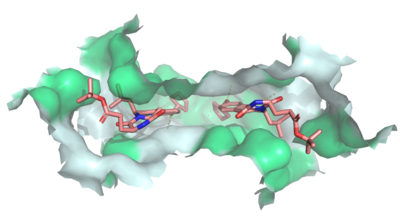Sandbox Reserved 1613
From Proteopedia
(Difference between revisions)
| Line 28: | Line 28: | ||
ABCG2 transports a variety of <scene name='83/832939/Mz29/1'>substrates</scene>, particularly flat, hydrophobic, and/or polycylic molecules. It is found in different biological membranes, such as the blood-brain barrier (BBB), blood-testis barrier, and the blood-placental barrier. It is thought to help protect those tissues and many others from cytotoxins. In addition to cytotoxin protection, ABCG2 secretes endogenous substrates in the adrenal gland, excretes toxins in the liver and kidneys, and regulates absorption of substrates. | ABCG2 transports a variety of <scene name='83/832939/Mz29/1'>substrates</scene>, particularly flat, hydrophobic, and/or polycylic molecules. It is found in different biological membranes, such as the blood-brain barrier (BBB), blood-testis barrier, and the blood-placental barrier. It is thought to help protect those tissues and many others from cytotoxins. In addition to cytotoxin protection, ABCG2 secretes endogenous substrates in the adrenal gland, excretes toxins in the liver and kidneys, and regulates absorption of substrates. | ||
<ref name="Fetsch">PMID:15990223</ref> | <ref name="Fetsch">PMID:15990223</ref> | ||
| - | + | ||
== Relevance == | == Relevance == | ||
By utilizing certain binders (<scene name='83/832939/5d3-fab/2'>5D3</scene>), it is able to be stabilized for crystallographic imaging.<ref name="Taylor">PMID:28554189</ref> This has allowed researchers in the past decade to make advances based upon the greater understanding of its structure. Using these advances, inhibitors have been found to stop effluxion by ABCG2. Completely inhibiting this function, however, has residual effects on the excretory system. One such effect is decreased uric acid excretion in both the kidneys and the gut, which causes [https://en.wikipedia.org/wiki/Hyperuricemia hyperuricemia] . This results in an increased risk of uric acid crystal build-up, known as [https://en.wikipedia.org/wiki/Tophus tophi formation], which causes a type of arthritis known as [https://en.wikipedia.org/wiki/Gout gout] . Balancing the inhibition of ABCG2 will determine how to lessen these effects while continuing to combat cancer resistivity.<ref name="Cleophas">PMID:28461764</ref> | By utilizing certain binders (<scene name='83/832939/5d3-fab/2'>5D3</scene>), it is able to be stabilized for crystallographic imaging.<ref name="Taylor">PMID:28554189</ref> This has allowed researchers in the past decade to make advances based upon the greater understanding of its structure. Using these advances, inhibitors have been found to stop effluxion by ABCG2. Completely inhibiting this function, however, has residual effects on the excretory system. One such effect is decreased uric acid excretion in both the kidneys and the gut, which causes [https://en.wikipedia.org/wiki/Hyperuricemia hyperuricemia] . This results in an increased risk of uric acid crystal build-up, known as [https://en.wikipedia.org/wiki/Tophus tophi formation], which causes a type of arthritis known as [https://en.wikipedia.org/wiki/Gout gout] . Balancing the inhibition of ABCG2 will determine how to lessen these effects while continuing to combat cancer resistivity.<ref name="Cleophas">PMID:28461764</ref> | ||
Revision as of 09:07, 21 April 2020
ABCG2 Transporter Protein
| |||||||||||
References
- ↑ Jackson SM, Manolaridis I, Kowal J, Zechner M, Taylor NMI, Bause M, Bauer S, Bartholomaeus R, Bernhardt G, Koenig B, Buschauer A, Stahlberg H, Altmann KH, Locher KP. Structural basis of small-molecule inhibition of human multidrug transporter ABCG2. Nat Struct Mol Biol. 2018 Apr;25(4):333-340. doi: 10.1038/s41594-018-0049-1. Epub, 2018 Apr 2. PMID:29610494 doi:http://dx.doi.org/10.1038/s41594-018-0049-1
- ↑ Manolaridis I, Jackson SM, Taylor NMI, Kowal J, Stahlberg H, Locher KP. Cryo-EM structures of a human ABCG2 mutant trapped in ATP-bound and substrate-bound states. Nature. 2018 Nov;563(7731):426-430. doi: 10.1038/s41586-018-0680-3. Epub 2018 Nov, 7. PMID:30405239 doi:http://dx.doi.org/10.1038/s41586-018-0680-3
- ↑ Fetsch PA, Abati A, Litman T, Morisaki K, Honjo Y, Mittal K, Bates SE. Localization of the ABCG2 mitoxantrone resistance-associated protein in normal tissues. Cancer Lett. 2006 Apr 8;235(1):84-92. doi: 10.1016/j.canlet.2005.04.024. Epub, 2005 Jun 28. PMID:15990223 doi:http://dx.doi.org/10.1016/j.canlet.2005.04.024
- ↑ Taylor NMI, Manolaridis I, Jackson SM, Kowal J, Stahlberg H, Locher KP. Structure of the human multidrug transporter ABCG2. Nature. 2017 Jun 22;546(7659):504-509. doi: 10.1038/nature22345. Epub 2017 May, 29. PMID:28554189 doi:http://dx.doi.org/10.1038/nature22345
- ↑ Cleophas MC, Joosten LA, Stamp LK, Dalbeth N, Woodward OM, Merriman TR. ABCG2 polymorphisms in gout: insights into disease susceptibility and treatment approaches. Pharmgenomics Pers Med. 2017 Apr 20;10:129-142. doi: 10.2147/PGPM.S105854., eCollection 2017. PMID:28461764 doi:http://dx.doi.org/10.2147/PGPM.S105854
- ↑ [ https://en.wikipedia.org/wiki/ABCG2 "ABCG2 -." Wikipedia, the Free Encyclopedia. Web. 20 Apr. 2020].
- ↑ Jackson SM, Manolaridis I, Kowal J, Zechner M, Taylor NMI, Bause M, Bauer S, Bartholomaeus R, Bernhardt G, Koenig B, Buschauer A, Stahlberg H, Altmann KH, Locher KP. Structural basis of small-molecule inhibition of human multidrug transporter ABCG2. Nat Struct Mol Biol. 2018 Apr;25(4):333-340. doi: 10.1038/s41594-018-0049-1. Epub, 2018 Apr 2. PMID:29610494 doi:http://dx.doi.org/10.1038/s41594-018-0049-1
Student Contributors
Shelby Skaggs, Samuel Sullivan, Jaelyn Voyles

